How to Prepare for the Everest Base Camp Trek in Nepal
18th October 2025
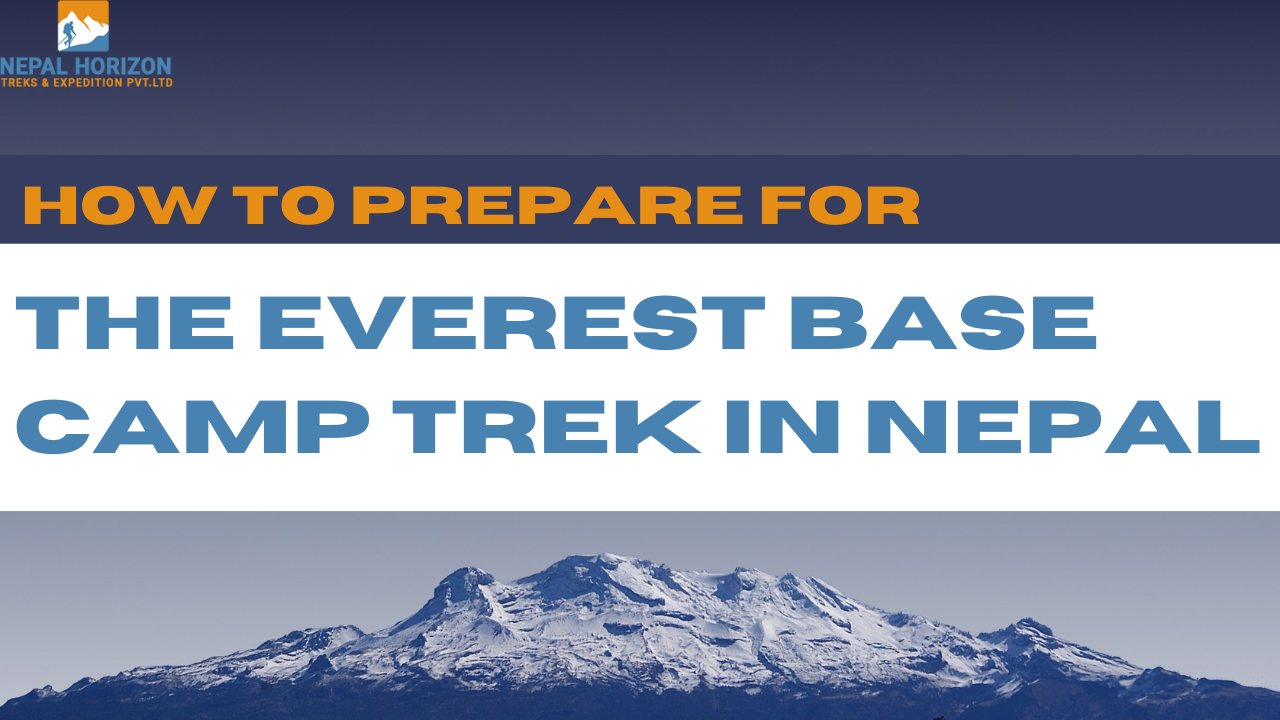
Everest Base Camp Trek in Nepal
The Everest Base Camp (EBC) trek is more than just a journey—it’s a dream adventure that takes you to the foot of the world’s highest mountain. Every step through the rugged Himalayan trails offers a unique blend of breathtaking scenery, cultural immersion, and personal achievement.
If you’ve ever imagined standing face-to-face with the majestic Mount Everest, this comprehensive Everest Base Camp trek guide will help you prepare for your ultimate Himalaya adventure.
1. Overview of the Everest Base Camp Trek
The Everest Base Camp trek in Nepal is one of the most iconic journeys on the planet. It combines the raw beauty of the Khumbu region, the vibrant Sherpa culture, and panoramic views of some of the world’s tallest peaks—Everest (8,848 m), Lhotse, Nuptse, and Ama Dablam.
This Nepal trekking experience begins with a short flight from Kathmandu to Lukla, followed by a trail that passes through picturesque villages, suspension bridges, and ancient monasteries. The trek culminates at Everest Base Camp (5,364 m) and the stunning viewpoint of Kala Patthar (5,545 m), offering one of the best panoramic views of Everest.
Quick Facts:
- Starting point: Lukla (2,860 m)
- Highest point: Kala Patthar (5,545 m)
- Duration: 12–16 days
- Region: Sagarmatha National Park, Nepal
- Difficulty: Moderate to challenging
2. Best Time to Visit Everest Base Camp
Choosing the right season is crucial for your EBC trek. The weather in the Himalayas can change dramatically, so trekking during favorable months ensures safety and clear views.
✅ Best Seasons:
- Spring (March–May): The most popular time for the Everest Base Camp experience, with rhododendrons blooming and warm, stable weather.
- Autumn (September–November): Crystal-clear skies, breathtaking mountain views, and comfortable temperatures make this the ideal time for trekking.
🚫 Avoid:
- Winter (December–February): Very cold, though possible for experienced trekkers.
- Monsoon (June–August): Heavy rain, slippery trails, and poor visibility.
3. Everest Base Camp Trek Duration and Itinerary
A typical Everest Base Camp itinerary lasts 12–16 days, depending on acclimatization and travel pace. Here’s a popular day-wise itinerary:
Day 1: Flight from Kathmandu to Lukla (2,860 m), trek to Phakding (2,610 m)
Day 2: Trek to Namche Bazaar (3,440 m)
Day 3: Acclimatization day in Namche Bazaar
Day 4: Trek to Tengboche (3,860 m)
Day 5: Trek to Dingboche (4,410 m)
Day 6: Acclimatization in Dingboche
Day 7: Trek to Lobuche (4,940 m)
Day 8: Trek to Gorak Shep (5,164 m), then hike to Everest Base Camp (5,364 m)
Day 9: Early morning hike to Kala Patthar (5,545 m) for sunrise views, descend to Pheriche
Day 10: Trek back to Namche Bazaar
Day 11: Return to Lukla
Day 12: Fly back to Kathmandu
Tip: Nepal Horizon Trek offers customized EBC trek packages with flexible itineraries to match your pace and interests.
4. Trekking Route and Major Stops
The Everest Base Camp trekking route follows a well-defined path through the Khumbu region, where each stop offers something unique:
Lukla (2,860 m)
The starting point of the trek, Lukla is famous for its thrilling airstrip and warm Sherpa hospitality.
Phakding (2,610 m)
A small riverside village perfect for the first night’s rest.
Namche Bazaar (3,440 m)
Known as the “Gateway to Everest,” Namche is the commercial hub of the region, with lodges, bakeries, and stunning views of Kongde Ri and Thamserku.
Tengboche (3,860 m)
Home to the Tengboche Monastery, the largest in the Khumbu region, offering serene views of Ama Dablam.
Dingboche (4,410 m)
A high-altitude village surrounded by stone-walled fields—an ideal place for acclimatization.
Lobuche and Gorak Shep
These are the final stops before reaching Everest Base Camp, where the landscape turns rugged and icy.
Kala Patthar (5,545 m)
A popular viewpoint that offers an unforgettable sunrise view over Mount Everest.
5. Accommodation and Meals
During your EBC trek, you’ll stay in tea houses—local lodges run by Sherpa families. These are simple but cozy, providing warm meals and a comfortable resting space.
Accommodation Includes:
- Twin-sharing rooms with basic bedding
- Shared bathrooms (some with hot showers at extra cost)
- Communal dining halls with wood stoves for warmth
Meals Include:
- Breakfast: Porridge, eggs, toast, tea, or coffee
- Lunch/Dinner: Dal Bhat (traditional Nepali meal), noodles, pasta, rice, and soup
“Dal Bhat power, 24-hour!” is a saying among trekkers—it’s nutritious and fuels long hiking days.
6. Trekking Difficulty Level and Fitness Requirements
The Everest Base Camp trek is considered moderate to challenging, but with proper preparation, most fit travelers can complete it.
Physical Fitness:
- Regular cardio training (walking, jogging, hiking) 2–3 months before your trip
- Strength exercises for legs and core stability
- Acclimatization is key—don’t rush the ascent
Mental Preparation:
The journey can be tough, with long walking days and altitude challenges. Stay positive and enjoy the experience—it’s as much a mental adventure as a physical one.
7. Cultural Experiences and Sherpa Hospitality
One of the most enriching parts of the EBC trek is interacting with the Sherpa community. Sherpas are renowned for their mountaineering expertise and warm hospitality.
During your trek, you’ll visit monasteries, spin prayer wheels, and observe Buddhist rituals that have shaped the spiritual life of the Himalayas for centuries.
From the colorful prayer flags fluttering in the wind to the chime of yak bells echoing through valleys, the Everest Base Camp experience is as cultural as it is scenic.
8. Safety, Permits, and Guidelines
Before you begin your Himalaya adventure, make sure you’re well-prepared with the necessary permits and safety precautions.
Required Permits:
- Sagarmatha National Park Entry Permit – NPR 3,000
- Khumbu Pasang Lhamu Rural Municipality Permit – NPR 2,000
These can be arranged easily through Nepal Horizon Trek or at the respective offices in Kathmandu and Lukla.
Safety Tips:
- Acclimatize properly to prevent altitude sickness.
- Stay hydrated and avoid alcohol at high altitudes.
- Follow your guide’s instructions at all times.
- Always carry travel insurance covering high-altitude trekking.
Your safety is our top priority at Nepal Horizon Trek. Our professional guides are trained in altitude awareness and first aid.
9. Essential Gear and Packing Tips
Packing smart is crucial for a successful Everest Base Camp trek. The weather can vary drastically from warm valleys to freezing peaks.
Must-Have Trekking Gear:
- Trekking boots (waterproof and broken-in)
- Down jacket and fleece layers
- Thermal base layers
- Trekking pants and shirts (quick-dry)
- Gloves, beanie, and sun hat
- Sleeping bag (rated for -10°C to -20°C)
- Trekking poles
- Sunglasses, sunscreen, and lip balm
- Headlamp and water purification tablets
Tip: Nepal Horizon Trek provides equipment rental assistance for trekkers who don’t want to buy all the gear.
10. Cost and Travel Recommendations
The Everest Base Camp trek cost depends on the duration, services, and package type.
Average Cost Range:
- Standard EBC trek: $1,200 – $1,800 per person
- Luxury EBC trek: $2,000 – $3,000 per person
This usually includes domestic flights, accommodation, meals, permits, guide, and porter services.
Travel Tips:
- Book flights to Lukla in advance—they fill up quickly.
- Carry some cash (Nepali rupees) for purchases along the trail.
- Choose a reliable trekking company like Nepal Horizon Trek for safety and a well-managed experience.
✈️ Plan your Everest Base Camp adventure with Nepal Horizon Trek today! Experience professional guidance, flexible itineraries, and unforgettable Himalayan hospitality.
11. Preparing Mentally and Physically
Beyond gear and logistics, mental readiness plays a vital role. The EBC trek demands endurance, patience, and determination. There may be moments of exhaustion, but every view, every sunrise, and every step toward the Base Camp will be worth it.
Meditate, visualize your journey, and remember—you’re walking in the footsteps of legends.
12. Responsible Trekking and Environmental Awareness
The Himalayas are pristine, and it’s every trekker’s duty to help preserve them.
- Carry a reusable water bottle and avoid plastic waste.
- Respect local culture and wildlife.
- Support local tea houses and buy local products.
Leave nothing but footprints; take nothing but memories.
Conclusion
The Everest Base Camp trek in Nepal is more than just reaching a destination—it’s about discovery, endurance, and connection with nature and culture. Whether you’re an experienced hiker or a first-time adventurer, this journey will test your limits and reward you with lifelong memories.
So, start preparing today—pack wisely, train your body, and keep your heart open to the wonders of the Himalayas.
Plan your Everest Base Camp trek with Nepal Horizon Trek and make your Himalayan dream a reality. Let our expert team guide you safely to the heart of Everest.
Frequently Asked Questions (FAQs)
1. How long does the Everest Base Camp trek take?
Most trekkers complete the EBC trek in 12–16 days, depending on acclimatization and pace.
2. Is the Everest Base Camp trek difficult?
It’s moderately challenging. With good fitness and mental preparation, anyone with a sense of adventure can complete it.
3. What is the best month to trek to Everest Base Camp?
March–May and September–November are the best months for clear skies and ideal weather.
4. Do I need a guide for the EBC trek?
Yes, having a licensed guide ensures safety, navigation, and cultural insight—especially in remote Himalayan areas.
5. How high is Everest Base Camp?
Everest Base Camp sits at 5,364 meters (17,598 feet) above sea level.
6. What is the cost of the EBC trek?
A standard Everest Base Camp trek costs around $1,200–$1,800, covering flights, accommodation, meals, permits, and guide services.
Experience the ultimate Himalaya adventure with Nepal Horizon Trek.
👉 Book your Everest Base Camp trek today and walk the legendary trails to the roof of the world
Recent From Blogs

18th October 2025
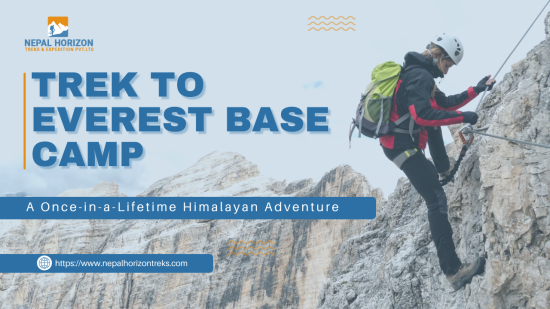
14th October 2025
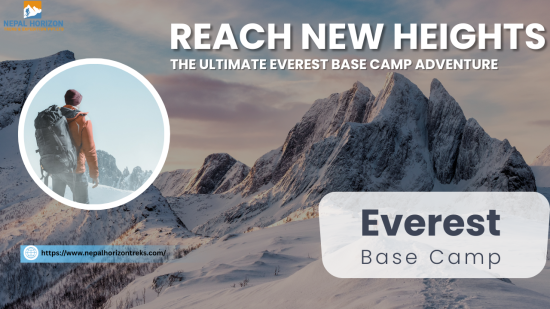
12th October 2025
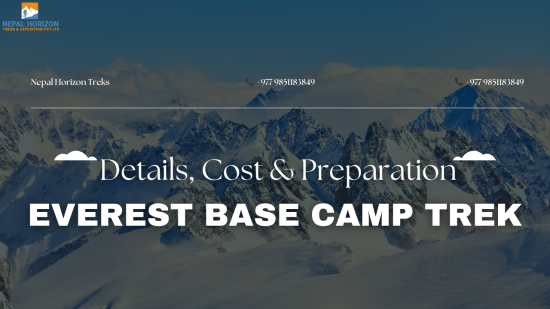
10th October 2025

7th October 2025

27th September 2025
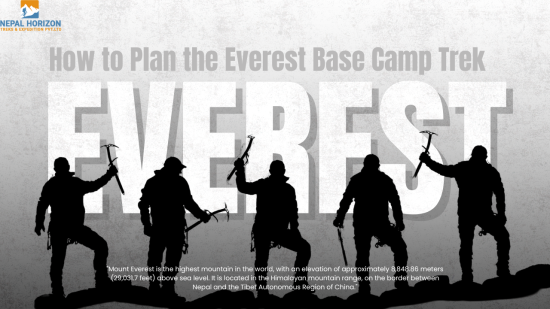
25th September 2025

22nd September 2025
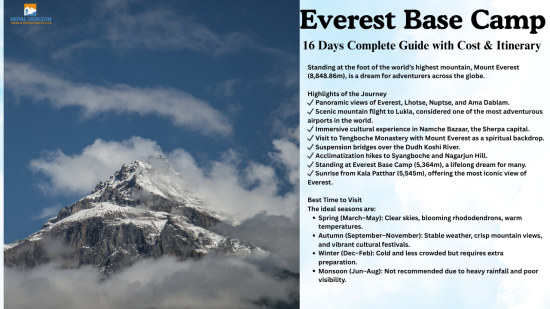
20th September 2025





